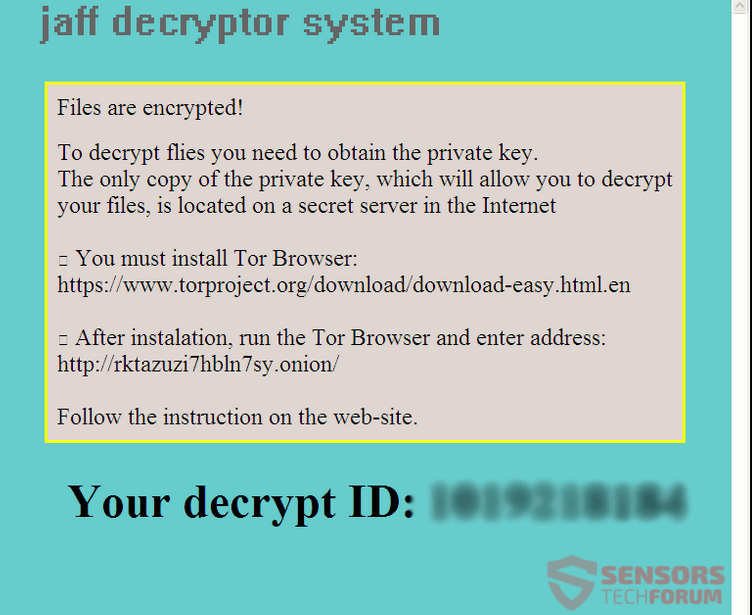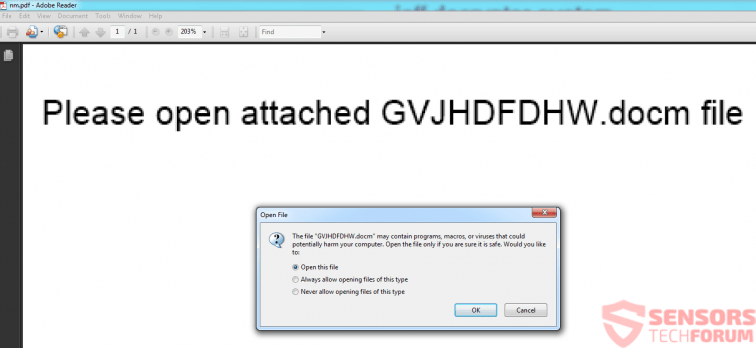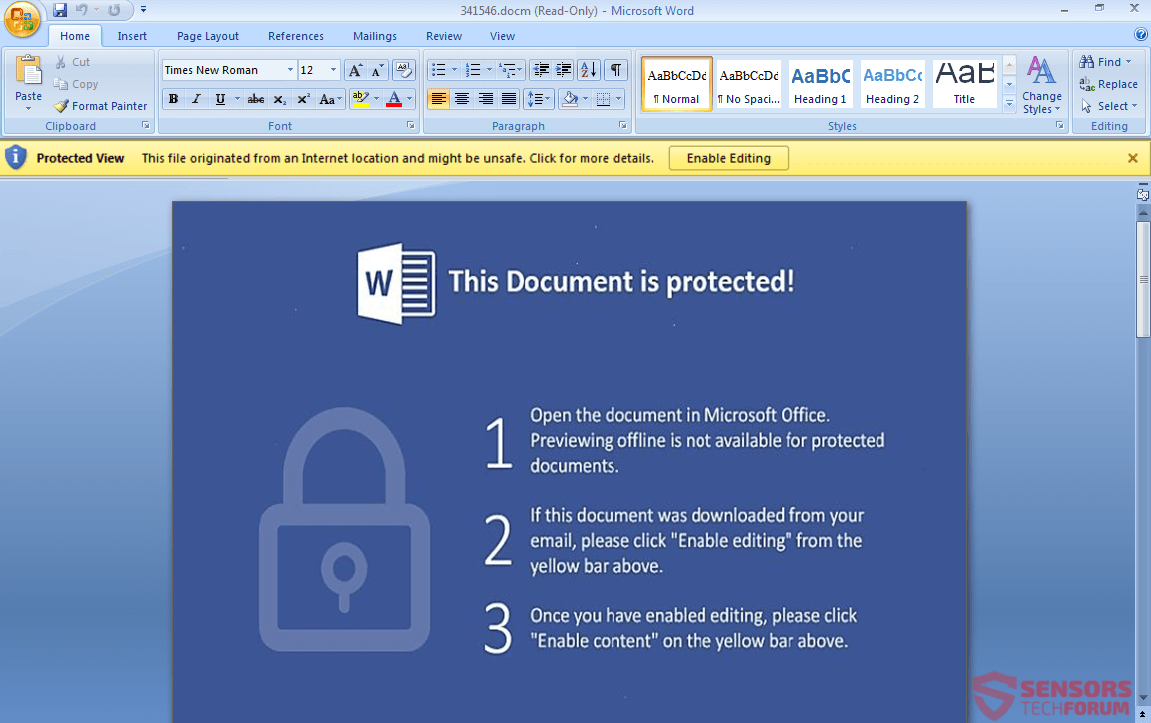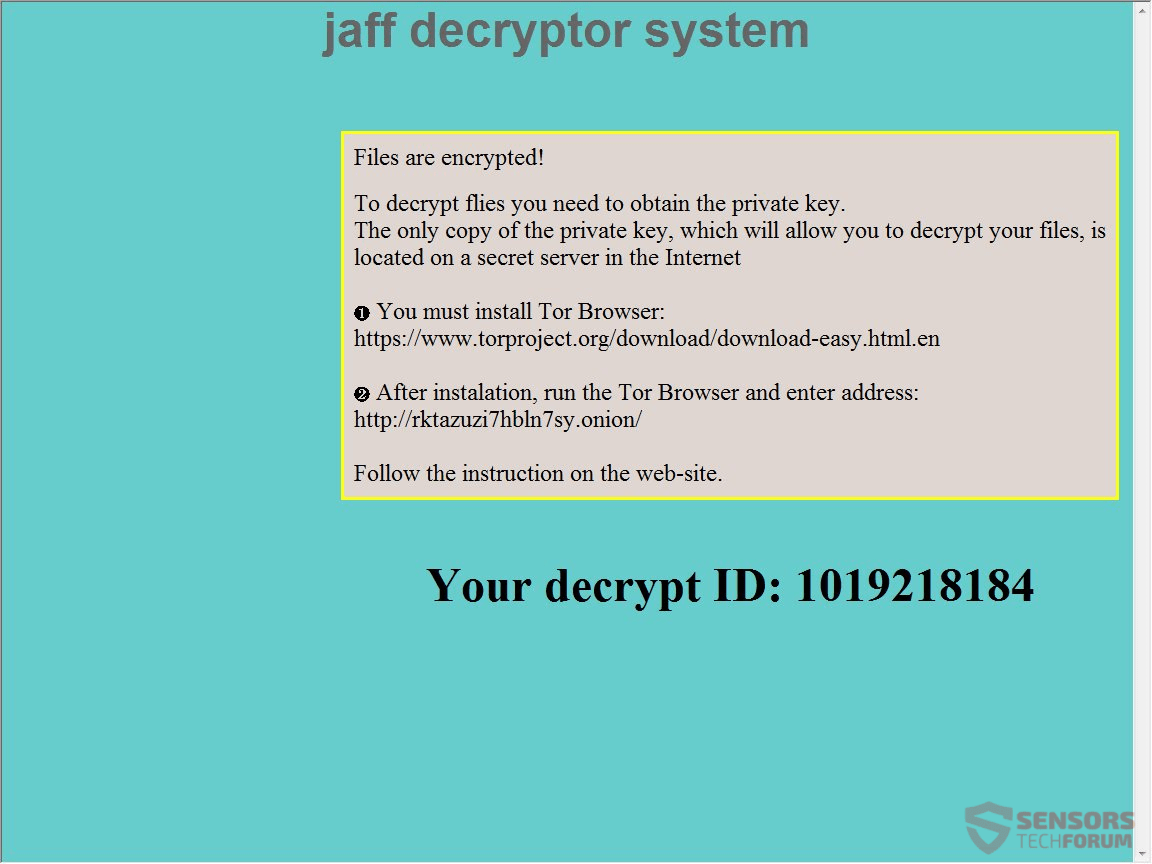The article will aid you to remove .Jaff File Virus effectively. Follow the .Jaff File Virus removal instructions at the end.
The .Jaff file virus is ransomware that encrypts data on your computer if it gets infected. Rumors about it being connected to the infamous Locky ransomware have dispersed after malware researchers have denied that being true. .Jaff will be the newly-appended extension to all files after they get encrypted. What is notable about the Jaff cryptovirus is that it copies some things from Locky like the payment page design, the way it spreads etc. Read on to see how you could try to potentially restore your files.

Threat Summary
| Name | .Jaff File Virus |
| Type | Ransomware, Cryptovirus |
| Short Description | .Jaff file virus mimics the distribution ways of the newest Locky ransomware variant making it successful in its infection. |
| Symptoms | The virus will encrypt your files and append the .Jaff extension on your files after it finishes the encryption process. |
| Distribution Method | Spam Emails with attachments, Macro commands hidden in fake documents |
| Detection Tool |
See If Your System Has Been Affected by malware
Download
Malware Removal Tool
|
User Experience | Join Our Forum to Discuss .Jaff File Virus. |
| Data Recovery Tool | Windows Data Recovery by Stellar Phoenix Notice! This product scans your drive sectors to recover lost files and it may not recover 100% of the encrypted files, but only few of them, depending on the situation and whether or not you have reformatted your drive. |

.Jaff File Virus – Update

.Jaff File Virus – Distribution Ways
Jaff ransomware not only utilizes the same distribution method used by the latest Locky virus, but it even surpasses it. That could be due to the probability of using another method for distribution alongside the ones it copies. Adding more to it, Jaff also copies the obfuscation (a tactic for malware to hide itself better) from the same source (Locky). Down here the distribution, extraction and infection ways of the .Jaff file virus will be explained.
Spam e-mail campaigns are in play, spreading millions of emails, which have PDF files attached to them.
Opening the PDF file will show the following:
Inside the PDF, you will see that there is an embedded .docm file, which you will be kindly asked to open up. This is how that document file looks from the inside if you open it up:
Once loaded, you will be asked to click on “Enable Editing” and right after that on “Enable Content”. From then on a macro script is loaded that will download the malicious executable for the .Jaff File Virus. The macro commands is detected to download the virus from one of the following URL locations:
- https://takanashi[.]jp/f87346b
- https://babil117[.]com/f87346b
- https://easysupport[.]us/f87346b
- https://julian-g[.]ro/f87346b
- https://phinamco[.]com/f87346b
- https://techno-kar[.]ru/f87346b
- https://tiskr[.]com/f87346b
- https://trans-atm[.]com/f87346b
- https://trialinsider[.]com/f87346b
- https://5hdnnd74fffrottd[.]com/af/f87346b
- https://boaevents[.]com/f87346b
- https://byydei74fg43ff4f[.]net/af/f87346b
- https://edluke[.]com/f87346b
- https://tending[.]info/f87346b
- https://vscard[.]net/f87346b
- https://wipersdirect[.]com/f87346b
Jaff ransomware could also be distributing its payload via social media networks and file-sharing sites. Refrain from opening files after downloaded them, especially if they come from places such as suspicious emails and links from an unknown source. Beforehand, you should scan the files with a security program, at the very least.

.Jaff File Virus – Technical Expertise
.Jaff file virus is ransomware, dubbed after the extension it places on files, after it encrypts them. Many have argued that it is a variant of the notorious Locky ransomware virus (.Loptr), due to the similarities between them. However, that has been proven otherwise by malware researchers who investigated the matter and concluded that their malicious code is different.
The .Jaff file virus copies Locky in more than one way, and uses that as a complementary scare tactic. Jaff is written on the “C” programming language, and its code is far less sophisticated than Locky. Still, that doesn’t exclude the possibility of the two ransomware viruses to share the same author. According to Proofpoint researchers, the malware spam campaigns for both viruses are currently spread via the Dridex Trojan, which itself is spread by the Necurs botnet. That’s some food for thought.
The .Jaff file virus makes entries in the Windows Registry to achieve a higher level of persistence, and even could launch and repress processes inside the Windows Operating System. Some of these entries are designed in a way that will start the virus automatically with every launch of Windows. A registry entry used by Jaff is:
→HKCU\Control Panel\Desktop\Wallpaper “C:\ProgramData\Rondo\WallpapeR.bmp”
The ransom note will be displayed after the encryption process finishes. The ransom note will be put inside three files, which are:
- ReadMe.bmp
- ReadMe.html
- ReadMe.txt
All three files will have almost exactly the same contents.
Here is how the note looks like from the ReadMe.html message:
From the instructions given on that ransom note, you will be pointed out to the TOR payment page of the .Jaff file virus:
The Tor page will have the same design as the one of Locky, but with some minor difference.
The payment page states the following:
jaff decryptor system™
We present a special software – jaff decryptor™ – Recovery all files
How to buy jaff decryptor™?
You can make a payment with BitCoins, there are many methods to get them.
You should register BitCoin wallet:
Simplest online wallet or Some other methods of creating wallet
Purchasing Bitcoins, although it’s not yet easy to buy bitcoins, it’s getting simpler every day.
Here are our recommendations:
localbitcoins.com (WU) Buy Bitcoins with Western Union.
coincafe.com Recommended for fast, simple service.
Payment Methods: Western Union, Bank of America, Cash by FedEx, Moneygram, Money Order. In NYC: Bitcoin ATM, in person.
localbitcoins.com Service allows you to search for people in your community willing to sell bitcoins to you directly.
cex.io Buy Bitcoins with VISA/MASTERCARD or wire transfer.
btcdirect.eu The best for Europe.
bitquick.co Buy Bitcoins instantly for cash.
howtobuybitcoins.info An international directory of bitcoin exchanges.
cashintocoins.com Bitcoin for cash.
coinjar.com CoinJar allows direct bitcoin purchases on their site.
anxpro.com
bittylicious.comSend 1.82196031 BTC to Bitcoin address:
15aCs4rGrfEs597hbo3PW93DVhTLTsxciiNote: Payment pending up to 30 mins or more for transaction confirmation, please be patient…
Date Amount BTC BTC address Confirmations
11.05.17, 09:20 1.82196031 15aCs4rGrfEs597hbo3PW93DVhTLTsxcii 0Refresh the page and download jaff decryptor
When Bitcoin transactions will receive one confirmation, you will be redirected to the page for downloading the jaff decryptor
Apparently the .Jaff File Virus demands you to pay 1.82 Bitcoin, which equals to 3.382 US dollars at the moment of writing this article. Despite that, you should NOT under any circumstances pay the ransom of the cybercriminals. Nobody can guarantee that you will get your files restored from paying, nor that you won’t get your computer infected again in the future. Providing money to these criminals will motivate them further in the creation of more ransomware viruses.

.Jaff File Virus – Encryption Process
Jaff ransomware seeks to encrypt files that have the following 424 extensions:
→.xlsx, .acd, .pdf, .pfx, .crt, .der, .cad, .dwg, .MPEG, .rar, .veg, .zip, .txt, .jpg, .doc, .wbk, .mdb, .vcf, .docx, .ics, .vsc, .mdf, .dsr, .mdi, .msg, .xls, .ppt, .pps, .obd, .mpd, .dot, .xlt, .pot, .obt, .htm, .html, .mix, .pub, .vsd, .png, .ico, .rtf, .odt, .3dm, .3ds, .dxf, .max, .obj, .7z, .cbr, .deb, .gz, .rpm, .sitx, .tar, .tar, .gz, .zipx, .aif, .iff, .m3u, .m4a, .mid, .key, .vib, .stl, .psd, .ova, .xmod, .wda, .prn, .zpf, .swm, .xml, .xlsm, .par, .tib, .waw, .001, .002 003, ., .004, .005, .006, .007, .008, .009, .010, .contact, .dbx, .jnt, .mapimail, .oab, .ods, .ppsm, .pptm, .prf, .pst, .wab, .1cd, .3g2, .7ZIP, .accdb, .aoi, .asf, .asp, . aspx, .asx, .avi, .bak, .cer, .cfg, .class, .config, .css, .csv, .db, .dds, .fif, .flv, .idx, .js, .kwm, .laccdb, .idf, .lit, .mbx, .md, .mlb, .mov, .mp3, .mp4, .mpg, .pages, .php, .pwm, .rm, .safe, .sav, .save, .sql, .srt, .swf, .thm, .vob, .wav, .wma, .wmv, .xlsb, .aac, .ai, .arw, .c, .cdr, .cls, .cpi, .cpp, .cs, .db3, .docm, .dotm, .dotx, .drw, .dxb, .eps, .fla, .flac, .fxg, .java, .m, .m4v, .pcd, .pct, .pl, .potm, .potx, .ppam, .ppsx, .ps, .pspimage, .r3d, .rw2, .sldm, .sldx, .svg, .tga, .wps, .xla, .xlam, .xlm, .xltm, .xltx, .xlw, .act, .adp, .al, .bkp, .blend, .cdf, .cdx, .cgm, .cr2, .dac, .dbf, .dcr, .ddd, .design, .dtd, .fdb, .fff, .fpx, .h, .iif, .indd, .jpeg, .mos, .nd, .nsd, .nsf, .nsg, .nsh, .odc, .odp, .oil, .pas, .pat, .pef, .ptx, .qbb, .qbm, .sas7bdat, .say, .st4, .st6, .stc, .sxc, .sxw, .tlg, .wad, .xlk, .aiff, .bin, .bmp, .cmt, .dat, .dit, .edb, .flvv, .gif, .groups, .hdd, .hpp, .log, .m2ts, .m4p, .mkv, .ndf, .nvram, .ogg, .ost, .pab, .pdb, .pif, .qed, .qcow, .qcow2, .rvt, .st7, .stm, .vbox, .vdi, .vhd, .vhdx, .vmdk, .vmsd, .vmx, .vmxf, .3fr, .3pr, .ab4, .accde, .accdt, .ach, .acr, .adb, .srw, .st5, .st8, .std, .sti, .stw, .stx, .sxd, .sxg, .sxi, .sxm, .tex, .wallet, .wb2, .wpd, .x11, .x3f, .xis, .ycbcra, .qbw, .qbx, .qby, .raf, .rat, .raw, .rdb rwl, .rwz, .s3db, .sd0, .sda, .sdf, .sqlite, .sqlite3, .sqlitedb, .sr, .srf, .oth, .otp, .ots, .ott, .p12, .p7b, .p7c, .pdd, .pem, .plus_muhd, .plc, .pptx, .psafe3, .py, .qba, .qbr, .myd, .ndd, .nef, .nk, .nop, .nrw, .ns2, .ns3, .ns4, .nwb, .nx2, .nxl, .nyf, .odb, .odf, .odg, .odm, .ord, .otg, .ibz, .iiq, .incpas, .jpe, .kc2, .kdbx, .kdc, .kpdx, .lua, .mdc, .mef, .mfw, .mmw, .mny, .moneywell, .mrw, .des, .dgc, .djvu, .dng, .drf, .dxg, .eml, .erbsql, .erd, .exf, .ffd, .fh, .fhd, .gray, .grey, .gry, .hbk, .ibank, .ibd, .cdr4, .cdr5, .cdr6, .cdrw, .ce1, .ce2, .cib, .craw, .crw, .csh, .csl, .db_journal, .dc2, .dcs, .ddoc, .ddrw, .ads, .agdl, .ait, .apj, .asm, .awg, .back, .backup, .backupdb, .bank, .bay, .bdb, .bgt, .bik, .bpw, .cdr3, .as4
Each one of the files that gets encrypted will receive the same extension appended to them, and that is the .Jaff extension. The encryption algorithms which are utilized by the ransomware are believed to be AES and RSA.
The Jaff cryptovirus could be set to erase the Shadow Volume Copies from the Windows operating system by using the following command:
→vssadmin.exe delete shadows /all /Quiet
If the command above is executed, it will make decryption efforts harder, if you try to use a recovery method that involves the Shadow Volume Copies. Continue reading and see in what ways the potential restoration of your files could work.

Remove .Jaff File Virus and Restore Files
If your computer got infected with the Jaff ransomware virus, you should have a bit of experience in removing malware. You should get rid of this ransomware as quickly as possible before it can have the chance to spread further and infect other computers. You should remove the ransomware and follow the step-by-step instructions guide provided below.
- Step 1
- Step 2
- Step 3
- Step 4
- Step 5
Step 1: Scan for .Jaff File Virus with SpyHunter Anti-Malware Tool



Ransomware Automatic Removal - Video Guide
Step 2: Uninstall .Jaff File Virus and related malware from Windows
Here is a method in few easy steps that should be able to uninstall most programs. No matter if you are using Windows 10, 8, 7, Vista or XP, those steps will get the job done. Dragging the program or its folder to the recycle bin can be a very bad decision. If you do that, bits and pieces of the program are left behind, and that can lead to unstable work of your PC, errors with the file type associations and other unpleasant activities. The proper way to get a program off your computer is to Uninstall it. To do that:


 Follow the instructions above and you will successfully delete most unwanted and malicious programs.
Follow the instructions above and you will successfully delete most unwanted and malicious programs.
Step 3: Clean any registries, created by .Jaff File Virus on your computer.
The usually targeted registries of Windows machines are the following:
- HKEY_LOCAL_MACHINE\Software\Microsoft\Windows\CurrentVersion\Run
- HKEY_CURRENT_USER\Software\Microsoft\Windows\CurrentVersion\Run
- HKEY_LOCAL_MACHINE\Software\Microsoft\Windows\CurrentVersion\RunOnce
- HKEY_CURRENT_USER\Software\Microsoft\Windows\CurrentVersion\RunOnce
You can access them by opening the Windows registry editor and deleting any values, created by .Jaff File Virus there. This can happen by following the steps underneath:


 Tip: To find a virus-created value, you can right-click on it and click "Modify" to see which file it is set to run. If this is the virus file location, remove the value.
Tip: To find a virus-created value, you can right-click on it and click "Modify" to see which file it is set to run. If this is the virus file location, remove the value.
Before starting "Step 4", please boot back into Normal mode, in case you are currently in Safe Mode.
This will enable you to install and use SpyHunter 5 successfully.
Step 4: Boot Your PC In Safe Mode to isolate and remove .Jaff File Virus





Step 5: Try to Restore Files Encrypted by .Jaff File Virus.
Method 1: Use STOP Decrypter by Emsisoft.
Not all variants of this ransomware can be decrypted for free, but we have added the decryptor used by researchers that is often updated with the variants which become eventually decrypted. You can try and decrypt your files using the instructions below, but if they do not work, then unfortunately your variant of the ransomware virus is not decryptable.
Follow the instructions below to use the Emsisoft decrypter and decrypt your files for free. You can download the Emsisoft decryption tool linked here and then follow the steps provided below:
1 Right-click on the decrypter and click on Run as Administrator as shown below:

2. Agree with the license terms:

3. Click on "Add Folder" and then add the folders where you want files decrypted as shown underneath:

4. Click on "Decrypt" and wait for your files to be decoded.

Note: Credit for the decryptor goes to Emsisoft researchers who have made the breakthrough with this virus.
Method 2: Use data recovery software
Ransomware infections and .Jaff File Virus aim to encrypt your files using an encryption algorithm which may be very difficult to decrypt. This is why we have suggested a data recovery method that may help you go around direct decryption and try to restore your files. Bear in mind that this method may not be 100% effective but may also help you a little or a lot in different situations.
Simply click on the link and on the website menus on the top, choose Data Recovery - Data Recovery Wizard for Windows or Mac (depending on your OS), and then download and run the tool.
.Jaff File Virus-FAQ
What is .Jaff File Virus Ransomware?
.Jaff File Virus is a ransomware infection - the malicious software that enters your computer silently and blocks either access to the computer itself or encrypt your files.
Many ransomware viruses use sophisticated encryption algorithms to make your files inaccessible. The goal of ransomware infections is to demand that you pay a ransom payment to get access to your files back.
What Does .Jaff File Virus Ransomware Do?
Ransomware in general is a malicious software that is designed to block access to your computer or files until a ransom is paid.
Ransomware viruses can also damage your system, corrupt data and delete files, resulting in the permanent loss of important files.
How Does .Jaff File Virus Infect?
Via several ways..Jaff File Virus Ransomware infects computers by being sent via phishing emails, containing virus attachment. This attachment is usually masked as an important document, like an invoice, bank document or even a plane ticket and it looks very convincing to users.
Another way you may become a victim of .Jaff File Virus is if you download a fake installer, crack or patch from a low reputation website or if you click on a virus link. Many users report getting a ransomware infection by downloading torrents.
How to Open ..Jaff File Virus files?
You can't without a decryptor. At this point, the ..Jaff File Virus files are encrypted. You can only open them once they are decrypted using a specific decryption key for the particular algorithm.
What to Do If a Decryptor Does Not Work?
Do not panic, and backup the files. If a decryptor did not decrypt your ..Jaff File Virus files successfully, then do not despair, because this virus is still new.
Can I Restore "..Jaff File Virus" Files?
Yes, sometimes files can be restored. We have suggested several file recovery methods that could work if you want to restore ..Jaff File Virus files.
These methods are in no way 100% guaranteed that you will be able to get your files back. But if you have a backup, your chances of success are much greater.
How To Get Rid of .Jaff File Virus Virus?
The safest way and the most efficient one for the removal of this ransomware infection is the use a professional anti-malware program.
It will scan for and locate .Jaff File Virus ransomware and then remove it without causing any additional harm to your important ..Jaff File Virus files.
Can I Report Ransomware to Authorities?
In case your computer got infected with a ransomware infection, you can report it to the local Police departments. It can help authorities worldwide track and determine the perpetrators behind the virus that has infected your computer.
Below, we have prepared a list with government websites, where you can file a report in case you are a victim of a cybercrime:
Cyber-security authorities, responsible for handling ransomware attack reports in different regions all over the world:
Germany - Offizielles Portal der deutschen Polizei
United States - IC3 Internet Crime Complaint Centre
United Kingdom - Action Fraud Police
France - Ministère de l'Intérieur
Italy - Polizia Di Stato
Spain - Policía Nacional
Netherlands - Politie
Poland - Policja
Portugal - Polícia Judiciária
Greece - Cyber Crime Unit (Hellenic Police)
India - Mumbai Police - CyberCrime Investigation Cell
Australia - Australian High Tech Crime Center
Reports may be responded to in different timeframes, depending on your local authorities.
Can You Stop Ransomware from Encrypting Your Files?
Yes, you can prevent ransomware. The best way to do this is to ensure your computer system is updated with the latest security patches, use a reputable anti-malware program and firewall, backup your important files frequently, and avoid clicking on malicious links or downloading unknown files.
Can .Jaff File Virus Ransomware Steal Your Data?
Yes, in most cases ransomware will steal your information. It is a form of malware that steals data from a user's computer, encrypts it, and then demands a ransom in order to decrypt it.
In many cases, the malware authors or attackers will threaten to delete the data or publish it online unless the ransom is paid.
Can Ransomware Infect WiFi?
Yes, ransomware can infect WiFi networks, as malicious actors can use it to gain control of the network, steal confidential data, and lock out users. If a ransomware attack is successful, it could lead to a loss of service and/or data, and in some cases, financial losses.
Should I Pay Ransomware?
No, you should not pay ransomware extortionists. Paying them only encourages criminals and does not guarantee that the files or data will be restored. The better approach is to have a secure backup of important data and be vigilant about security in the first place.
What Happens If I Don't Pay Ransom?
If you don't pay the ransom, the hackers may still have access to your computer, data, or files and may continue to threaten to expose or delete them, or even use them to commit cybercrimes. In some cases, they may even continue to demand additional ransom payments.
Can a Ransomware Attack Be Detected?
Yes, ransomware can be detected. Anti-malware software and other advanced security tools can detect ransomware and alert the user when it is present on a machine.
It is important to stay up-to-date on the latest security measures and to keep security software updated to ensure ransomware can be detected and prevented.
Do Ransomware Criminals Get Caught?
Yes, ransomware criminals do get caught. Law enforcement agencies, such as the FBI, Interpol and others have been successful in tracking down and prosecuting ransomware criminals in the US and other countries. As ransomware threats continue to increase, so does the enforcement activity.
About the .Jaff File Virus Research
The content we publish on SensorsTechForum.com, this .Jaff File Virus how-to removal guide included, is the outcome of extensive research, hard work and our team’s devotion to help you remove the specific malware and restore your encrypted files.
How did we conduct the research on this ransomware?
Our research is based on an independent investigation. We are in contact with independent security researchers, and as such, we receive daily updates on the latest malware and ransomware definitions.
Furthermore, the research behind the .Jaff File Virus ransomware threat is backed with VirusTotal and the NoMoreRansom project.
To better understand the ransomware threat, please refer to the following articles which provide knowledgeable details.
As a site that has been dedicated to providing free removal instructions for ransomware and malware since 2014, SensorsTechForum’s recommendation is to only pay attention to trustworthy sources.
How to recognize trustworthy sources:
- Always check "About Us" web page.
- Profile of the content creator.
- Make sure that real people are behind the site and not fake names and profiles.
- Verify Facebook, LinkedIn and Twitter personal profiles.






